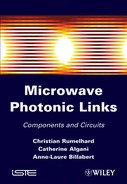Preface
Two important areas of applications of microwave photonic links are electromagnetic sensors and radio-over-fiber (RoF) applications.
Electromagnetic sensor microwave systems of the future will principally use active phased-array antennas. The development will be determined by reliability requirements, resistance to interference, and total emission flexibility of the beamforming networks. This type of antenna would therefore be used in a diverse range of applications, e.g. radar, communication, and countermeasures. To satisfy this multifunctional approach, it will be necessary to distribute these antennas all over the surface area of strategic platforms (planes, drones, boats, etc), While, on the ground, the multistatic mode of operation will force multiple antennas to be deported from their processing unit.
This will require links with very low loss and noise, enabling remote-control antennas and the distribution and processing of very wide bandwidth microwave signals (typically 1-20 GHz; 40 GHz will be seen in the future).
Currently the maturity and performance, notably in terms of spectral purity and opto-electronic component linearity, are such that it is possible to consider both optical distribution and processing of these electrical signals. Thus, the optical transmission of microwaves offers as well as propagation of broad frequency bands, advantages regarding weight, volume, and flexibility characterized by a decrease in the weight of the wiring by 90% in comparison to coaxial cables; and thus insensitivity to electromagnetic perturbation. All of which will enable the introduction of new concepts in microwave systems based on optical architecture.
Several sensor radar systems have been designed and produced in France, the United States, the UK, and Italy, and photonic technology for the distribution of microwave signals is already being used for ground, airborne and aerospace applications.
Fiber-optic distribution network technology is an emergence of this technology platform, in reference to the design of opto-electronic links for the transmission of microwave and digital signals. This optical wiring aims to replace coaxial wiring for onboard electronics interconnections. Here the term transmission is taken in the sense that microwave transmissions on optical carriers are in-phase.
These functions require the design of emitting and receiving optoelectronic modules, the integration of both high thermal stability multiplexing/ demultiplexing functions and single-mode connectors, either point to point or multipoints.
Another area of reference is the optical control of the phase and/or delay of microwave signals, and their applications to electromagnetic sensor systems. This occurs by the design of ultrafast opto-electronic multi-chip modules incorporating the optically-controlled switching, the control synthesis of time delay systems, and the multiwave laser sources.
Amongst the most promising technologies is the synthesis of mono- and bidimensional time-delays for the single and multiple beamforming in receiver and emitter, the ultraprecise (picoseconds) time synchronization of distributed electromagnetic sensors, the time-delay control (precision in the order of picoseconds) of very wide bandwidth microwave signals to measure the arrival direction and the waveshape generation.
Another important area involving all RoF applications is the extensive development of wireless networks using microwaves or ultra-wideband signals. This is achieved by providing optical tunnels capable of reaching all areas of a company, university, etc., or all the rooms of a house, whilst benefiting from the very low loss associated with fiber optics.
In their work titled “Microwave Photonic Links”, C. Rumelhard, C. Algani, and A.-L Billabert studied and developed models of the components and photonic functions in microwave applications, thus laying the foundation for research into microwave photonic links in order to allow the integration of these components in electromagnetic sensors systems. The components and functions addressed range from optical sources (modulated semiconductor lasers or externally modulated continuous lasers) to photodetectors, optical fibers, and optical amplifiers.
This work focuses upon optical components, their transfer functionality and their modeling in terms of microwave components, in order to create an electrical model of microwave photonic links. In order to achieve this level of complexity, a number of modeling approaches have been created by the authors to elucidate the influences of the constituent components of microwave photonic links.
Because the advancement of opto-electronics, photonics, and microwaves is possible by the unification of modeling approaches, there is no doubt that such works will be referenced by students, but also by design engineers and architects of electromagnetic sensor systems who will incorporate this new technology into their designs.
This is, to the author’s knowledge, the first work addressing the description and modeling of microwave photonic link technology, with an educational approach to physical phenomena and new approaches to modeling microwave photonic components.
